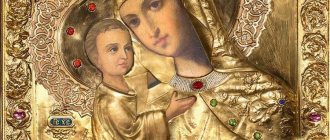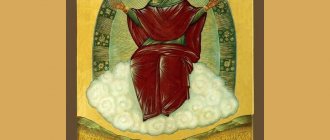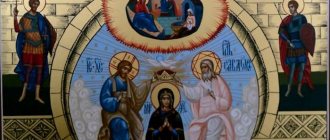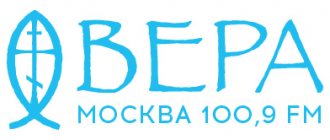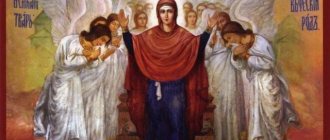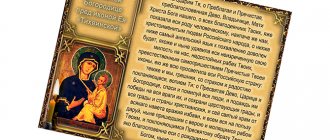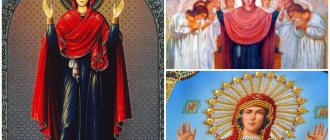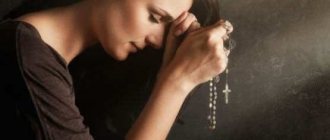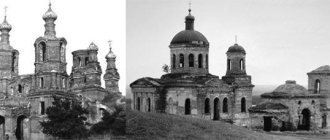Wood, tempera. 31 × 26.5 cm, Central Museum of Ancient Russian Culture and Art named after. Andrey Rublev, Moscow, Russia
The Mother of God knows all our sorrows and sufferings, therefore it is to her that those who are perishing resort to prayer for deliverance from eternal death. Being on the brink of eternal destruction, in despair, having lost hope of salvation, many are capable of reckless actions. But it is very important to gather our strength and thoughts and remember our first intercession before God.
Veneration of the icon
It is with a request for spiritual salvation that believers resort to the face of the Mother of God “Vp”. Her veneration began in Asia, in the 6th century; in Rus' this image has been revered since the 18th century.
The day of celebration of the icon is February 18.
Origin of the name “Recovery of the Lost” and the legend of an early miracle in Asia Minor
No one knows when and how this image appeared. But this name was given to it by Theophilus of Adan. According to legend, he lived in the 6th century, served as a housekeeper in the bishop's house, was very decent and did his job conscientiously. After the death of Bishop Theophilos, they tried to appoint him to his position, but he refused, because... He considered himself unworthy of such responsible work and remained in his previous rank.
Useful materials
Envious people accused the steward of theft, and the new bishop removed him from office. He grumbled against God, and the thought of revenge arose in his soul. He renounced the Lord and began to serve Satan. The bishop eventually decided to return him to service and then Theophilus woke up from the devil’s captivity. He secluded himself and for several days cried out to the Mother of God for forgiveness and salvation for him, the “perishing” one, kneeling before her icon and calling Her “the seeker of the lost.” Finally, prayers were answered and Theophilus was forgiven.
Subsequently, he led such a righteous life that in the Catholic Church he was glorified as a saint for this; the day of his veneration falls on February 4.
Miracles in Russia
In Russia, the first miracles of this icon were revealed in the 18th century. First, she saved a freezing peasant from certain death. Fedot Obukhov was caught in a snowstorm on the road; the road was so snowy that the horses could not continue on their way. Freezing, Fedot began to pray to the Most Holy Theotokos and promised, if he survived, to write a list of her image “Recovery of the Lost” for the local church. Soon he was accidentally discovered by local residents, and Fedot miraculously survived.
When he came to the icon painter to order an icon, he asked for a very high price for it, for which the Mother of God at that very moment deprived him of his sight. He repented of his greed and agreed to paint the image at any cost.
In the middle of the 18th century, prayers before the icon “Seeking the Lost” saved a widower with three daughters from spiritual decline. He lost his beloved wife, lost his fortune, unable to withstand such trials, he began to drink. In despair, he began to pray in front of the image of the Mother of God for his salvation and for the dispensation of his girls. Soon his life improved, and the girls got married safely. He took the miraculous image to the Moscow Church of the Nativity in Palashi, so that other residents could resort to the intercession of the Most Pure Virgin.
How does the “Recovery of the Lost” icon help?
Icons of this type are divided into several types, on some icons of the Mother of God “Seeking the Lost”, She is depicted with a covered head, and on some with uncovered and unclasped hands. Other authors include additional elements such as a landscape in a window and saints. There is an icon “Seeking the Lost” in Moscow, in this image the Mother of God without a headdress and surrounded by saints.
The Mother of God has endless love for people and a desire to help everyone who is lost along the way.
She is ready to forgive and help everyone who is on the verge of death
The images become a symbol that motivates one to pray tirelessly and proclaim the truth. She is the intercessor of sick people who are unable to heal. She confidently saves everyone who is in poverty and making ends meet. Briefly, the meaning of the icon “Seeking the Lost” can be described as salvation for everyone burdened and dejected, who has lost all hope and desire to live.
People go to this image to ask to save a sick baby or an unborn child. She has repeatedly shown miracles, freeing mothers from suffering and painful experiences, so she becomes the patroness of children and teenagers, who also find it good to pray in front of this image.
To such icons of the Mother of God as “Seeking the Lost,” “The Burning Bush,” and Vladimirskaya, people try to turn to her with fervent requests and prayers to heal a seriously ill person or relative. Sincere prayer to the image helps to get rid of unnecessary vices, including addiction to alcohol and drugs.
Sinners who have repented come to her to ask for forgiveness and the opportunity to return to the path of God.
Women ask for a happy family and the health of all household members. She is able to protect a person who is on the battlefield and strives with all his heart to go home. It can heal fevers, eye diseases and various ailments. Thousands of Orthodox people turn to her for help every year, and the importance in Orthodox culture is difficult to overestimate.
Legends associated with Matrona of Moscow
One day Saint Matronushka told her mother: “Mom, I keep dreaming about the icon “Recovery of the Lost.” She blessed the collection of funds for the icon. Many donated large sums with joy, some gave a ruble reluctantly, and some even gave their last penny to a good cause. When the required amount was collected, an artist was found who claimed that he was a master of his craft and that the work would soon be ready. Matrona told him to fast all these days, and before starting work he must confess and take communion.
After some time, the artist announced that he would not paint the image, because... he can't do anything. Matrona realized that he had concealed his sin during confession, and ordered him to go to the sacrament again and correct the disastrous mistake. He repented, asked everyone for forgiveness and painted an image that is still next to Matrona.
Origin story
The first mention of the icon of the Most Holy Theotokos “Seeking the Lost” dates back to the sixth century. According to legend, the image saved the monk Theophilus from eternal death and helped him achieve spiritual perfection. The earliest image in Rus' is considered to be an icon that was located in the St. George Church of the Oryol province, dating back to the beginning of the eighteenth century. She gained her fame after the miraculous rescue of the peasant Theodot Obukhov from death.
Theodotus was engaged in various crafts, buying hemp seed from villages, going to the village temple, donating icons for it. One day he found himself in a terrible blizzard. His horse stopped near the ravine, because due to lack of strength it could hardly move. The peasant was chilled and saw no salvation, so he decided to fall asleep in the sleigh and wait. He prayed to the Mother of God and vowed that if he were saved, he would make a list of the “Retribution” and install it in his local church.
And so it happened - thanks to the help of the Mother of God, Theodotus was miraculously saved. Theodotus woke up in a neighboring village, his friend found him in a sleigh with a horse right near his house. The peasant was warmed and fed, and, having recovered his health, Theodotus began to fulfill his oath and created a handwritten copy of the icon of the Most Holy Theotokos with the Baby Jesus in her arms.
Iconography of the image, details, symbolism
On the icons, the Mother of God is depicted with the Child Jesus. He stands on Mother's knees, rarely - She holds Him in her arms. The feet of the Divine Infant are always visible from under the robe. He pressed his face to the cheek of the Most Holy Mother, hugging Her neck. The Ever-Virgin's head is rarely covered with maforia, it is mostly open, the hair is loose and flows to the shoulders.
Vologda, approx. 1783, Wood, tempera, 31.5 × 24.5 cm
Sometimes the Queen of Heaven and Her Son are depicted wearing crowns. The Mother's hands are closed in a ring around the Baby, the fingers are connected into a lock. In some cases, the face is painted among the clouds, both in full height and in a half-length depiction of the Virgin Mary.
Symbolism of the divine face
The ancient image symbolizes the endless love of the Mother of God for every person, the desire of the Holy Virgin to protect and save all those in need of support.
Church ministers advise not to associate the word “lost”, which is present in the name of the icon, with the dead. It refers to people who have ceased to enjoy life, have lost its meaning and are in need of spiritual revival.
The religious shrine carries the following meaning:
- The Mother of God forgives all people who have repented of their sins and extends a divine helping hand to them;
- The Mother of God is the intercessor of every sick person who is unable to be healed or who is on the verge of death;
- The Most Pure One saves everyone who is in extreme poverty, starving, and deprived of the opportunity to make ends meet.
According to Orthodox priests, the essence of the icon “Seeking the Lost” is the salvation of all burdened and dejected people who have lost all hope and desire to live. The divine face helps repentant sinners who regret their past life and sincerely want to take the path of God.
The icon with the image of the Most Holy Theotokos and the little Christ fights for all those who sincerely ask. The divine face nourishes every believer with the necessary strength, protects against negative influences, and warns against mistakes in choosing the right path.
Honored Lists
The most revered copy (copy) is the Moscow icon, the same one that helped a widower marry off his daughters. Now it is in the Resurrection Church, located in Bryusov Lane. The image was badly damaged during the Patriotic War of 1812. Then the French destroyed the Church of the Nativity, and the icon itself split into three parts. The church was rebuilt, the parts of the icon were combined, and it remained there until 1934, then it found its home in Moscow.
Another list is also located in Moscow, in the Church of the Venerable Robe of the Lord in the Assumption Cathedral. There are also such shrines in the Moscow region, both are in Serpukhov, one in the Vysotsky Monastery, the second in St. Nicholas Cathedral.
First prayer
Oh, Most Holy and Most Blessed Virgin, Lady Theotokos! Look with Your merciful eye on us, standing before Your holy icon and praying to You with tenderness, raise us from the depths of sin, enlighten our minds, darkened by passions, and heal the ulcers of our souls and bodies. We are not imams of other help, not imams of other hope, do You, Lady, weigh all our infirmities and sins? We resort to You and cry out: do not forsake us with Your Heavenly help, but appear to us ever and with Your ineffable mercy and bounties, save and have mercy on us , dying. Grant us correction of our sinful life and deliver us from sorrows, troubles and illnesses, from vain death, hell and eternal torment. You, Queen and Lady, are the quick Helper and Intercessor of all who flow to You, and a strong refuge for repentant sinners. Grant us, O Most Blessed and All-Immaculate Virgin, the Christian end of our life, peaceful and unashamed, and grant us, through Your intercession, to dwell in the heavenly abodes, where the unceasing voice of those celebrating with joy glorifies the Most Holy Trinity, the Father, and the Son, and the Holy Spirit, now and ever , and forever and ever. Amen.
Second prayer
Zealous Intercessor, Compassionate Mother of the Lord, I come running to You, the accursed one and the most sinful man above all, listen to the voice of my prayer, hear my cry and groans, as if my iniquities have surpassed my head, and I, like a ship in the abyss, am plunging into the sea of my sins . But You, All-Good and Merciful Lady, do not despise me, desperate and perishing in sins; have mercy on me, who repent of my evil deeds, and turn my lost, accursed soul to the right path. On You, my Lady Theotokos, I place all my hope. Thou, Mother of God, preserve and keep me under Thy roof, now and ever, and unto ages of ages. Amen.
What requests are made to the icon?
Prayers performed before the “Discipline” may contain various requests:
- about recovery from many diseases (both your own and those of your loved ones);
- about strengthening faith in the Lord, gaining spiritual purity;
- about protection during epidemics, military operations, and other situations that pose a threat to life or health;
- about forgiveness of committed sins, the opportunity to again take the path of God.
People who want to give up alcohol, drugs, or other addictions come to venerate the image and beg for its help. Their relatives and friends can also ask for relief from such a painful burden.
The icon “Seeking the Lost” patronizes children and teenagers, who can pray in front of it independently or together with their parents. Single girls and women ask her for a successful marriage, the birth of healthy children in marriage, harmonious relationships and the absence of conflicts in the family.
Third prayer
O Most Holy Lady and Mother of God, the highest Cherub and the most honorable Seraphim, God's chosen Youth, the Seeker of the lost and the Joy of all who mourn, grant consolation to us who exist in perdition and sorrow, unless You have no other refuge and help than the Imams. You are the only one who is the Intercessor of our joy, and as the Mother of God and Mother of Mercy, standing at the Throne of the Most Holy Trinity, you can help us: no one else, who flows to You, leaves in shame. Hear us now, on the day of destruction and sorrow, falling before Your icon and praying to You with tears: take away from us the sorrows and troubles that are upon us in this temporary life, so that through Your omnipotent intercession, do not deprive us of eternal, endless joys in the Kingdom son
